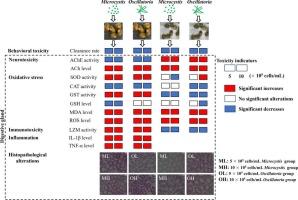浮游微囊藻和底栖振荡藻对大型底栖动物的生物学效应
IF 4.3
3区 环境科学与生态学
Q2 BIOCHEMISTRY & MOLECULAR BIOLOGY
Comparative Biochemistry and Physiology C-toxicology & Pharmacology
Pub Date : 2025-07-28
DOI:10.1016/j.cbpc.2025.110301
引用次数: 0
摘要
天然淡水中蓝藻水华和蓝藻衍生物污染的同时存在对水生生物群和人类构成严重威胁。迄今为止,蓝藻,特别是被忽视的底栖有毒蓝藻,可能对底栖动物造成潜在的有害影响。了解底栖动物对这些有毒蓝藻的可能反应对于评估蓝藻水华引起的生态风险非常重要。本研究研究了浮游微囊藻(Microcystis aeruginosa)和底栖振荡藻(Oscillatoria sp.)在暴露14 d后对淡水大型底栖动物(Lamprotula leai)和蜗牛(Bellamya aeruginosa)摄食行为、组织结构、神经毒性、氧化应激和免疫毒性的影响。首先,两种蓝藻可以降低蛤蜊和蜗牛的清除率,造成它们消化腺的组织损伤。其次,两种蓝藻细菌可以通过改变蛤和蜗牛消化腺的乙酰胆碱酯酶活性和乙酰胆碱水平诱导其神经毒性。第三,两种蓝藻可以通过改变蛤和蜗牛消化腺的抗氧化酶活性、谷胱甘肽水平、丙二醛水平和活性氧水平,导致蛤和蜗牛的氧化应激。最后,两种蓝藻细菌可以通过改变蛤和蜗牛消化腺溶菌酶活性引起免疫毒性,同时两种蓝藻细菌还可以通过增加蛤和蜗牛消化腺中白细胞介素-1β和肿瘤坏死因子-α的水平诱导炎症反应。这些数据表明,有毒蓝藻会威胁大型底栖生物的健康,而底栖蓝藻引起的不良生态影响不容忽视。本文章由计算机程序翻译,如有差异,请以英文原文为准。

Biological effects of planktonic Microcystis and benthic Oscillatoria on macro-benthic animals
The concurrent presence of cyanobacterial blooms and cyanobacterial derivative pollution in natural freshwater poses serious threats to aquatic biota and human beings. To date, cyanobacteria, especially ignored benthic toxic cyanobacteria, may cause potential harmful impacts on benthic animals. Understanding benthic animals' possible responses to these toxic cyanobacteria is important for assessing cyanobacterial bloom-induced ecological risks. This study investigated the harmful impacts of planktonic Microcystis aeruginosa (generating microcystin) and benthic Oscillatoria sp. (generating cylindrospermopsin) on the feeding behavior, tissue structure, neurotoxicity, oxidative stress, and immunotoxicity of the freshwater macrobenthos clams Lamprotula leai and snails Bellamya aeruginosa under 14-d exposure. Firstly, two cyanobacteria can reduce the clearance rates of clams and snails, causing tissue damage in their digestive glands. Secondly, two cyanobacteria can induce neurotoxicity in clams and snails by altering acetylcholinesterase activities and acetylcholine levels in their digestive glands. Thirdly, two cyanobacteria can lead to oxidative stress in clams and snails by changing the antioxidant enzyme activities, glutathione levels, malondialdehyde levels, and reactive oxygen species levels in their digestive glands. Finally, two cyanobacteria can cause immunotoxicity in clams and snails by altering lysozyme activities in their digestive glands, while two cyanobacteria can also induce inflammatory responses in clams by increasing levels of interleukin-1β and tumor necrosis factor-α in their digestive glands. These data indicated that toxic cyanobacteria can threaten the health of macrobenthos, and the benthic cyanobacteria-induced adverse ecological impacts should not be ignored.
求助全文
通过发布文献求助,成功后即可免费获取论文全文。
去求助
来源期刊
CiteScore
7.50
自引率
5.10%
发文量
206
审稿时长
30 days
期刊介绍:
Part C: Toxicology and Pharmacology. This journal is concerned with chemical and drug action at different levels of organization, biotransformation of xenobiotics, mechanisms of toxicity, including reactive oxygen species and carcinogenesis, endocrine disruptors, natural products chemistry, and signal transduction with a molecular approach to these fields.

 求助内容:
求助内容: 应助结果提醒方式:
应助结果提醒方式:


